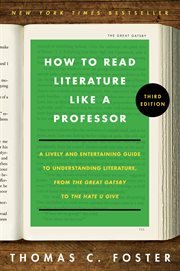Nonfiction
eBook
Details
PUBLISHED
Made available through hoopla
DESCRIPTION
1 online resource (336 pages)
ISBN/ISSN
LANGUAGE
NOTES
A thoroughly revised and expanded edition of Thomas C. Foster's classic guide-a lively and entertaining introduction to literature and literary basics, including symbols, themes and contexts, that shows you how to make your everyday reading experience more rewarding and enjoyable. While many books can be enjoyed for their basic stories, there are often deeper literary meanings interwoven in these texts. How to Read Literature Like a Professor helps us to discover those hidden truths by looking at literature with the eyes-and the literary codes-of the ultimate professional reader, the college professor. What does it mean when a literary hero is traveling along a dusty road? When he hands a drink to his companion? When he's drenched in a sudden rain shower? Ranging from major themes to literary models, narrative devices and form, Thomas C. Foster provides us with a broad overview of literature-a world where a road leads to a quest, a shared meal may signify a communion, and rain, whether cleansing or destructive, is never just a shower-and shows us how to make our reading experience more enriching, satisfying, and fun. This revised edition includes new chapters, a new preface and epilogue, and incorporates updated teaching points that Foster has developed over the past decade. Foster updates his classic text with ore writers and books in the contemporary pantheon, including: Angie Thomas's The Hate U Give, Emily St. John Mandel's Station Eleven, Neil Gaiman's Neverwhere, Elizabeth Acevedo's The Poet X ), Helen Oyeyemi's Mr. Fox and Boy, Snow, Bird, Sandra Cisneros's The House on Mango Street, Zora Neale Hurston's Their Eyes Were Watching God, Maggie O'Farrell's Hamnet, Madeline Miller's Circe, Pat Barker's The Silence of the Girls, and Tahereh Mafi's A Very Large Expanse of Sea. "I know of no other book that so vividly conveys what it's like to study with a great literature professor." -James Shapiro, Columbia University, author of Shakespeare and the Jews It is a common situation that is all too familiar to literature professors everywhere. When teaching a great work of literature, be it Lorraine Hansberry's A Raisin in the Sun (1959), Henry Fielding's Tom Jones (1741), or Toni Morrison's Beloved (1987), there is inevitably a moment in the classroom discussion of the book when the students confess to their professor that they do not "get it," they simply do not understand the inherent symbolism represented in the book of which the professor speaks of with such clarity and ease. As Thomas C. Foster states in his enlightening new book How to Read Literature Like a Professor, to the eager but frustrated literature student "it may seem at times as if the professor is either inventing interpretations out of thin air or else performing parlor tricks, a sort of analytical sleight of hand." Of course, literature professors have an obvious unfair advantage over their students: they are experienced readers who over the years have acquired an integral skill that Foster labels the "language of reading," something their students are only just beginning to understand. The "language of reading" is the grammar of literature, a set of conventions and patterns, codes and rules that are employed when dealing with a piece of writing. Quite simply, what does it mean when a fictional character embarks on a journey? Or gets caught in a torrential rainstorm? Or sits down to share a hearty meal with family and friends? In How to Read Literature Like a Professor,Thomas C. Foster presents a lively and entertaining guide for your students to learn the subtle clues that form the "language of reading," thereby transforming their reading experience to a new level that is ultimately more enriching, satisfying, and fun. Written in an informal, friendly style that encourages a freewheeling approach to literature, How to Read L
Mode of access: World Wide Web







